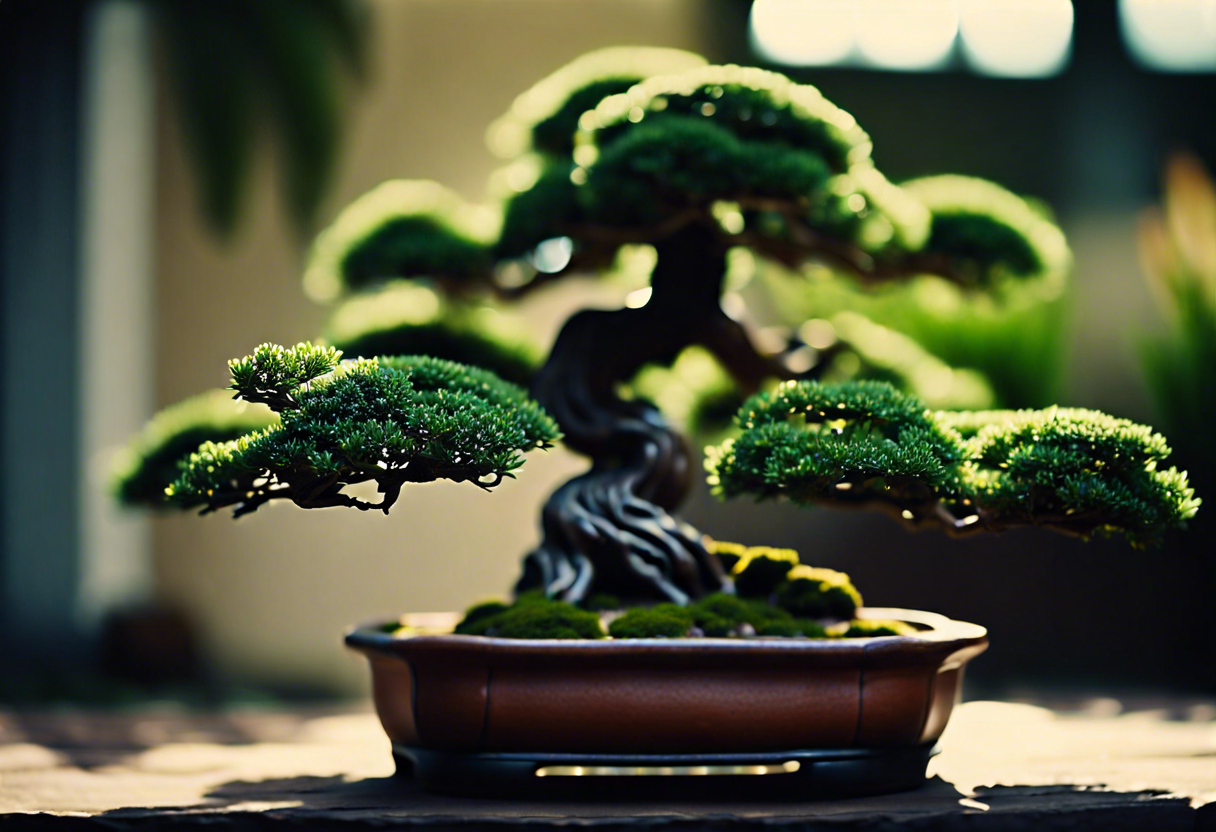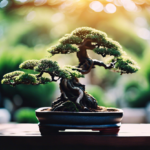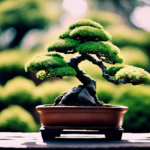Step-by-step guide on how to make a bonsai tree
Creating a bonsai tree is a rewarding and meditative process that requires patience and attention to detail. Here is a step-by-step guide to help you embark on your bonsai-making journey:
1. Selecting the Right Plant:
Choose a plant species that is well-suited for bonsai cultivation. Common options include ficus, juniper, pine, and maple. Consider factors such as the plant’s growth habits, leaf size, and overall aesthetic appeal.
2. Choosing the Right Container:
Opt for a shallow container with drainage holes to ensure proper water drainage and root aeration. The container should complement the size and style of your bonsai tree.
3. Preparing the Plant:
Carefully remove the plant from its original container and trim the roots to promote healthy growth in the new container. Prune any damaged or overgrown branches to achieve the desired shape.
4. Planting the Bonsai:
Create a well-draining bonsai soil mix using components such as akadama, pumice, and lava rock. Gently place the plant in the container, adding soil in layers to secure the roots and provide stability.
5. Shaping and Wiring:
Use bonsai wire to gently shape the tree’s trunk and branches, guiding them into the desired position. Avoid wiring too tightly to prevent damage to the plant. Regularly check the wiring and adjust as needed.
6. Watering and Feeding:
Maintain proper moisture levels by watering the bonsai when the soil starts to dry out. Use a balanced fertilizer during the growing season to promote healthy foliage and vibrant blooms.
7. Pruning and Maintenance:
Regularly prune the bonsai tree to maintain its shape and encourage new growth. Remove any dead or diseased branches, and repot the plant every few years to refresh the soil and root system.
By following these steps and investing time and care into your bonsai tree, you can create a stunning living work of art that will bring beauty and tranquility to your space. Remember, bonsai cultivation is a continuous learning process, so don’t be afraid to experiment and refine your techniques over time.
For more detailed information on bonsai tree making, check out Bonsai Empire for expert tips and inspiration.
Choosing the Right Plant Species for Your Bonsai Project
Choosing the right plant species is a crucial first step in creating a beautiful bonsai tree. Not all plants are suitable for bonsai cultivation, so it is essential to select the right species that will thrive in a confined environment and respond well to bonsai techniques. Here are some key factors to consider when choosing a plant for your bonsai project.
Factors to Consider:
1. Hardiness Zone: Consider the climate in which you live and choose a plant species that is appropriate for your hardiness zone. Different plants require specific temperature ranges to thrive and survive, so it’s essential to select a species that can withstand your local climate conditions.
2. Size: Decide on the size of the bonsai tree you envision creating. Some plant species naturally lend themselves to being smaller in size and are more suitable for bonsai cultivation. Consider the ultimate size you want your bonsai tree to be when selecting a plant species.
3. Leaf Size and Shape: The size and shape of the leaves of the plant species you choose will affect the overall aesthetics of your bonsai tree. Some species have smaller leaves that are more proportionate to the miniature size of bonsai trees, while others have larger leaves that may not be as visually appealing in a bonsai setting.
4. Growing Habits: Consider the growth habits of the plant species you are considering. Some plants grow quickly and vigorously, which may require more frequent pruning and maintenance to keep them in bonsai form. Others grow more slowly and are easier to train and shape.
5. Woody Species: Many bonsai enthusiasts prefer woody plant species for their bonsai projects as they develop a thick trunk and gnarled bark over time, adding to the beauty and character of the tree. Common woody species used for bonsai include junipers, maples, pines, and azaleas.
Choosing the right plant species is a critical decision that will impact the success and longevity of your bonsai project. By considering factors such as hardiness zone, size, leaf characteristics, growing habits, and woody species, you can select a plant that is well-suited for bonsai cultivation and that will bring you joy for years to come. Remember to research each species thoroughly and choose one that aligns with your skill level and aesthetic preferences.
For more information on selecting the right plant species for your bonsai project, you can visit Bonsai Empire for a comprehensive guide to bonsai tree species.
Essential Tools and Materials Needed for Bonsai Tree Making
Creating a beautiful bonsai tree requires the right tools and materials to ensure its health and longevity. Here is a detailed list of essential items you will need to start your bonsai project:
1. Bonsai Soil:
Choosing the right soil mix is crucial for the development of your bonsai tree. Bonsai soil should provide good drainage while retaining enough moisture for the roots. You can purchase pre-mixed bonsai soil or create your mix using components like akadama, pumice, and lava rock.
2. Bonsai Pots:
Selecting the appropriate pot for your bonsai is essential for both aesthetic appeal and the tree’s health. Bonsai pots come in various shapes, sizes, and materials like ceramic or clay. Ensure the pot has drainage holes to prevent waterlogging.
3. Pruning Shears:
Quality pruning shears are necessary for shaping and maintaining your bonsai tree. Choose shears that are sharp and comfortable to handle. Regular pruning helps control the growth of branches and encourages leaf growth in desired areas.
4. Wire Cutters and Bonsai Wire:
Bonsai wire is used to train the branches of your tree into the desired shape. Wire cutters specifically designed for bonsai work are crucial for safely removing the wire once the branch has set in place. Be cautious not to leave the wire on for too long to avoid damaging the branches.
5. Root Rake and Tweezers:
Maintaining healthy roots is essential for the overall well-being of your bonsai tree. A root rake aids in combing out the roots during repotting, while tweezers help in delicately pruning and maintaining the root system.
6. Watering Can or Spray Bottle:
Proper watering is key to keeping your bonsai tree thriving. A watering can with a fine spout or a spray bottle can help you control the amount of water your tree receives. Avoid overwatering, as it can lead to root rot and other issues.
7. Fertilizer:
Fertilizing your bonsai tree provides essential nutrients for healthy growth. Choose a balanced bonsai fertilizer and follow the recommended dosage instructions. Fertilize your tree during the growing season for optimal results.
Investing in quality tools and materials is a crucial step in the journey of creating and maintaining a beautiful bonsai tree. By having the right equipment at your disposal, you can enjoy the art of bonsai cultivation and watch your tree flourish over time.
For more detailed information on bonsai tools and materials, visit link-to-related-website.
Tips for shaping and pruning your bonsai tree
When it comes to shaping and pruning your bonsai tree, there are several key tips to keep in mind to ensure the health and aesthetics of your miniature masterpiece. Proper shaping and pruning techniques are essential for maintaining the unique form and balance of a bonsai tree. Here are some valuable tips to guide you through the process:
-
Understand the Basics: Before you start shaping and pruning your bonsai tree, it’s crucial to understand the specific growth patterns and needs of the tree species you are working with. Different species require different approaches to shaping and pruning to thrive.
-
Use the Right Tools: Sharp and precise tools are essential for shaping and pruning bonsai trees effectively. Tools such as concave cutters, pruning shears, and bonsai knives are commonly used to trim branches and foliage with precision.
-
Follow the Natural Form: When shaping your bonsai tree, try to follow its natural form and growth pattern. Bonsai should mimic the shape and movement of full-sized trees in nature, so take cues from the tree’s natural tendencies when pruning and shaping.
-
Practice Regular Maintenance: Regular maintenance, including pruning and shaping, is necessary to keep your bonsai tree healthy and aesthetically pleasing. Make it a habit to inspect your bonsai regularly and perform necessary pruning to maintain its shape and balance.
-
Consider Branch Placement: When shaping your bonsai tree, pay attention to the placement of branches to create a harmonious and balanced design. Remove any branches that disrupt the overall balance or symmetry of the tree.
-
Patience is Key: Shaping and pruning bonsai trees is an ongoing process that requires patience and dedication. Avoid making drastic changes in a single pruning session and allow the tree time to recover and grow before further shaping.
-
Seek Guidance: If you’re new to bonsai tree shaping and pruning, consider joining a local bonsai club or seeking guidance from experienced enthusiasts. Learning from seasoned bonsai practitioners can provide valuable insights and tips for shaping and maintaining your bonsai tree.
By following these tips for shaping and pruning your bonsai tree, you can create a beautiful and well-maintained miniature tree that reflects the artistry and tradition of bonsai cultivation. Remember to approach shaping and pruning with care and consideration for the unique needs of your bonsai tree to achieve stunning results.
For more in-depth guidance on shaping and pruning bonsai trees, visit Bonsai Empire for expert tips and resources specifically tailored to bonsai enthusiasts.
Maintaining the Health and Beauty of Your Bonsai Tree
After putting in the effort to create your bonsai tree, it’s essential to know how to care for it properly to ensure its health and beauty for years to come. Maintaining a bonsai tree involves several key tasks that contribute to its overall well-being.
Watering: Proper watering is crucial for the health of your bonsai tree. It’s essential to check the soil regularly to ensure it doesn’t dry out completely. Depending on the species of your bonsai, you may need to water it daily or every few days. It’s best to water your bonsai thoroughly, allowing the water to drain out of the bottom of the pot to prevent waterlogging.
Light: Bonsai trees need an adequate amount of light to thrive. Place your bonsai in a location where it will receive the right amount of sunlight. However, be mindful of direct sunlight, as it can scorch the leaves of your bonsai. If you notice the leaves turning yellow or brown, it may be a sign that your bonsai is getting too much light.
Fertilizing: Regular fertilization is essential for the growth and health of your bonsai tree. Use a balanced liquid fertilizer or a slow-release fertilizer to provide your bonsai with the necessary nutrients. Fertilize your bonsai during the growing season, typically in the spring and summer months.
Pruning and Shaping: Regular pruning and shaping help maintain the aesthetic appeal of your bonsai tree. Trim back new growth to maintain the desired shape and size of your bonsai. Additionally, remove any dead or yellowing leaves to encourage new growth.
Repotting: Repotting your bonsai tree every few years helps refresh the soil and encourage healthy root growth. Repot your bonsai in the spring before the growing season begins. Use well-draining soil and a pot that provides adequate drainage to prevent root rot.
By following these maintenance tips, you can ensure that your bonsai tree remains healthy and beautiful for years to come. Remember that each bonsai species may have specific care requirements, so it’s essential to research the needs of your particular bonsai tree. For more in-depth guidance on bonsai tree care, you can visit Bonsai Empire.
Conclusion
Cultivating a bonsai tree is a rewarding and enriching experience that requires patience, dedication, and a love for nature. By following a step-by-step guide, selecting the appropriate plant species, acquiring the essential tools and materials, practicing effective shaping and pruning techniques, and maintaining the health and beauty of your bonsai tree, you can embark on a journey that combines artistry and horticulture in a harmonious union.
As discussed in this comprehensive guide, the first step in creating a bonsai tree involves choosing the right plant species that suits your climate and personal preferences. Whether you opt for a traditional pine tree or a flowering cherry blossom, selecting a species that resonates with you is crucial for a successful bonsai project.
Equally important is investing in the essential tools and materials needed for bonsai tree making. From special pruning shears and wire cutters to well-draining soil and fertilizer, having the right equipment at your disposal will facilitate the pruning, shaping, and overall care of your bonsai tree.
When it comes to shaping and pruning your bonsai tree, having a steady hand and an artistic eye are key. By following expert tips and techniques, such as wiring branches for desired shapes and trimming excess foliage for balanced growth, you can sculpt your bonsai tree into a miniature work of art that reflects your vision and creativity.
Furthermore, maintaining the health and beauty of your bonsai tree requires regular watering, fertilizing, and repotting as needed. By monitoring the soil moisture, providing adequate sunlight, and protecting your bonsai tree from pests and diseases, you can ensure its longevity and vitality for years to come.
In essence, the art of making a bonsai tree is a harmonious blend of skill, creativity, and patience. By embarking on this journey with enthusiasm and dedication, you can cultivate a living masterpiece that brings joy, tranquility, and a deep connection to the natural world. So, roll up your sleeves, pick up your tools, and get ready to create your own stunning bonsai tree – a symbol of beauty, serenity, and the art of mindful cultivation.


